ESP MITSUBISHI ENDEAVOR 2004 Service User Guide
[x] Cancel search | Manufacturer: MITSUBISHI, Model Year: 2004, Model line: ENDEAVOR, Model: MITSUBISHI ENDEAVOR 2004Pages: 3870, PDF Size: 98.47 MB
Page 1097 of 3870
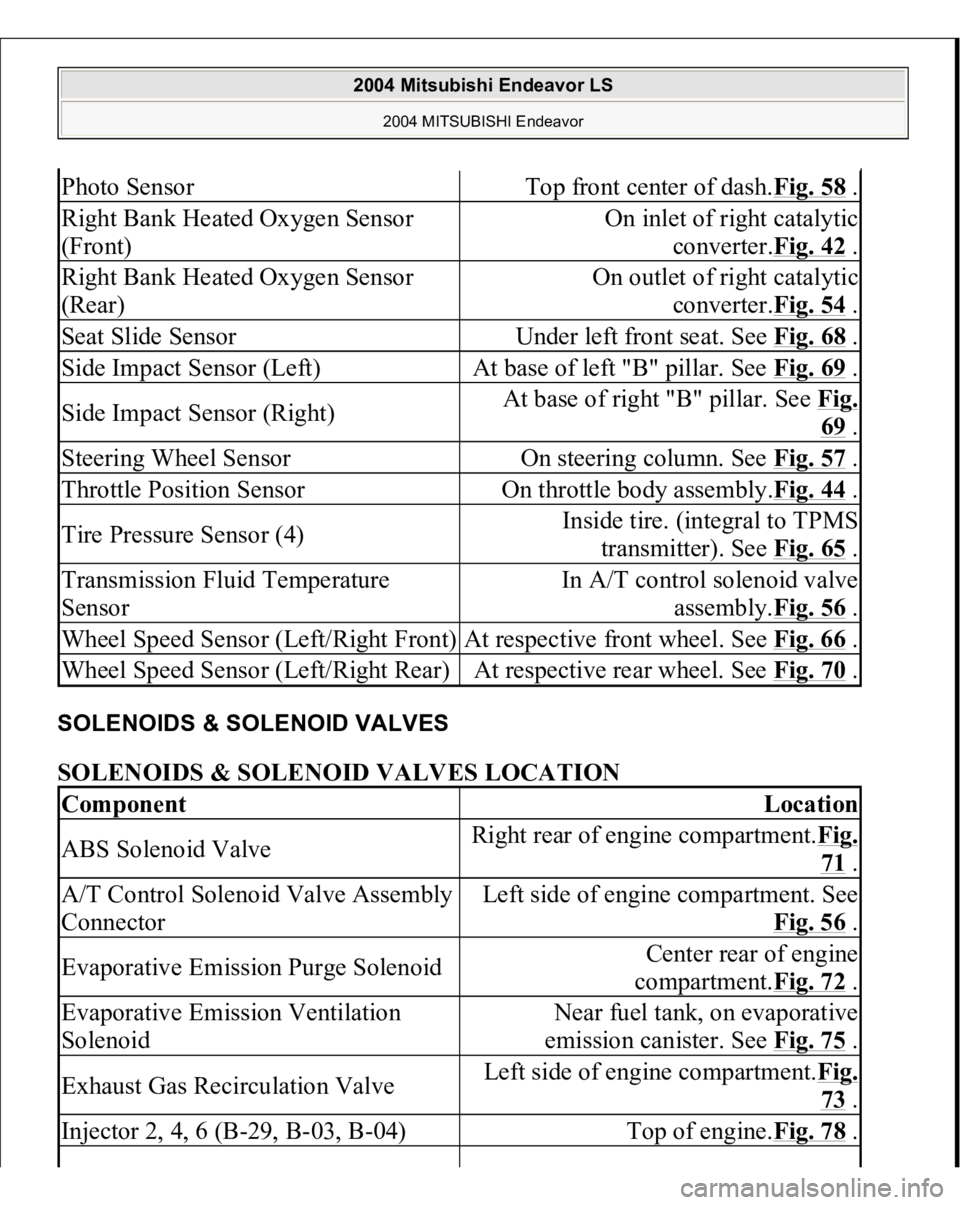
SOLENOIDS & SOLENOID VALVES SOLENOIDS & SOLENOID VALVES LOCATION Photo Sensor
Top front center of dash.Fig. 58
.
Right Bank Heated Oxygen Sensor
(Front)
On inlet of right catalytic
converter.Fig. 42
.
Right Bank Heated Oxygen Sensor
(Rear)
On outlet of right catalytic
converter.Fig. 54
.
Seat Slide Sensor
Under left front seat. See Fig. 68
.
Side Impact Sensor (Left)
At base of left "B" pillar. See Fig. 69
.
Side Impact Sensor (Right)
At base of right "B" pillar. See Fig.
69 .
Steering Wheel Sensor
On steering column. See Fig. 57
.
Throttle Position Sensor
On throttle body assembly.Fig. 44
.
Tire Pressure Sensor (4)
Inside tire. (integral to TPMS
transmitter). See Fig. 65
.
Transmission Fluid Temperature
Sensor
In A/T control solenoid valve
assembly.Fig. 56
.
Wheel Speed Sensor (Left/Right Front)
At respective front wheel. See Fig. 66
.
Wheel Speed Sensor (Left/Right Rear)
At respective rear wheel. See Fig. 70
.
Component
Location
ABS Solenoid Valve
Right rear of engine compartment.Fig.
71 .
A/T Control Solenoid Valve Assembly
Connector
Left side of engine compartment. See
Fig. 56
.
Evaporative Emission Purge Solenoid
Center rear of engine
compartment.Fig. 72
.
Evaporative Emission Ventilation
Solenoid
Near fuel tank, on evaporative
emission canister. See Fig. 75
.
Exhaust Gas Recirculation Valve
Left side of engine compartment.Fig.
73 .
Injector 2, 4, 6 (B-29, B-03, B-04)
Top of engine.Fig. 78
.
2004 Mitsubishi Endeavor LS
2004 MITSUBISHI Endeavor
Page 1302 of 3870
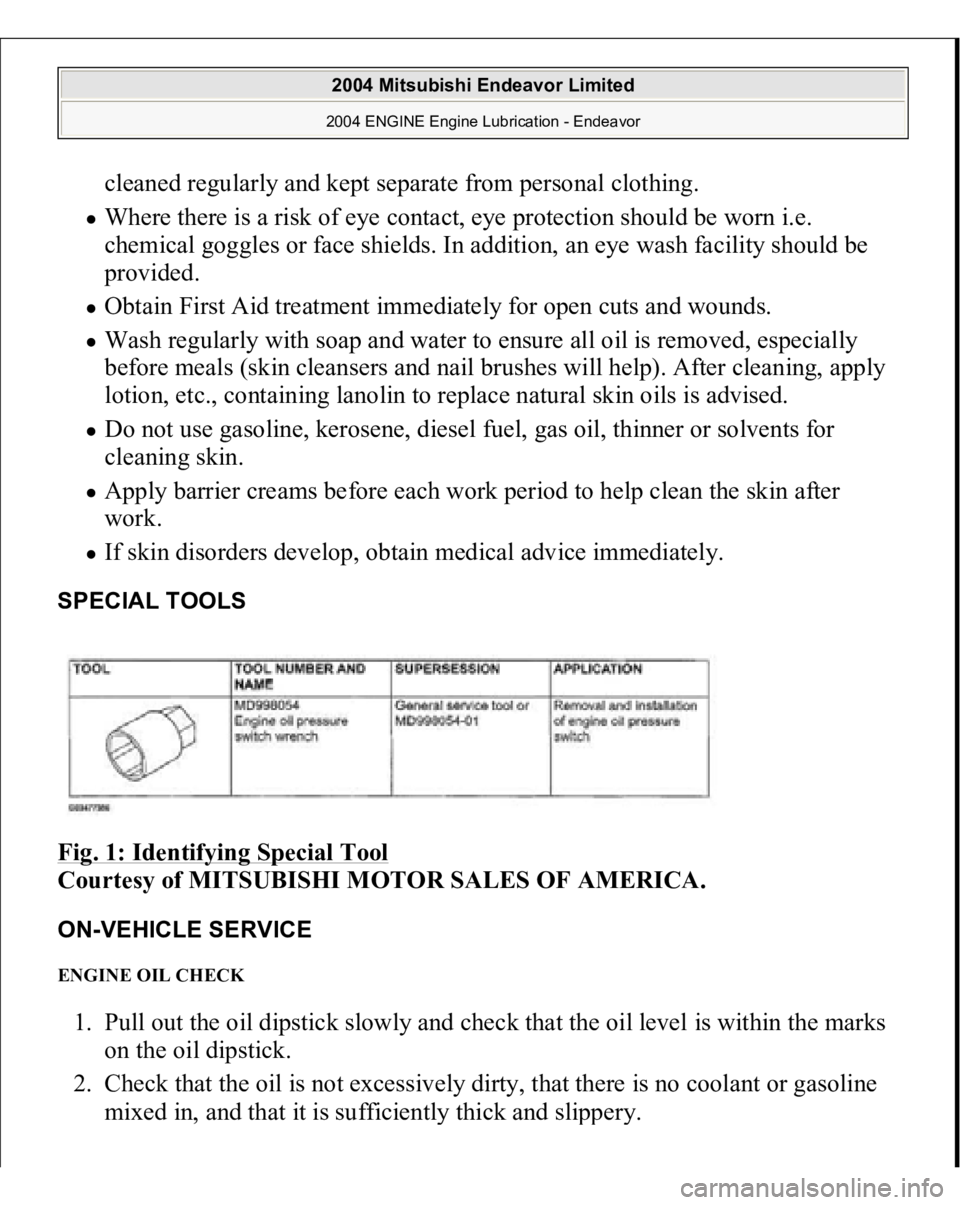
cleaned regularly and kept separate from personal clothing. Where there is a risk of eye contact, eye protection should be worn i.e.
chemical goggles or face shields. In addition, an eye wash facility should be
provided. Obtain First Aid treatment immediately for open cuts and wounds. Wash regularly with soap and water to ensure all oil is removed, especially
before meals (skin cleansers and nail brushes will help). After cleaning, apply
lotion, etc., containing lanolin to replace natural skin oils is advised. Do not use gasoline, kerosene, diesel fuel, gas oil, thinner or solvents for
cleaning skin. Apply barrier creams before each work period to help clean the skin after
work. If skin disorders develop, obtain medical advice immediately.
SPECIAL TOOLS Fig. 1: Identifying Special Tool
Courtesy of MITSUBISHI MOTOR SALES OF AMERICA.
ON-VEHICLE SERVICE ENGINE OIL CHECK 1. Pull out the oil dipstick slowly and check that the oil level is within the marks
on the oil dipstick.
2. Check that the oil is not excessively dirty, that there is no coolant or gasoline
mixed in, and that it is sufficientl
y thick and sli
ppery.
2004 Mitsubishi Endeavor Limited 2004 ENGINE Engine Lubrication - Endeavor
Page 1461 of 3870
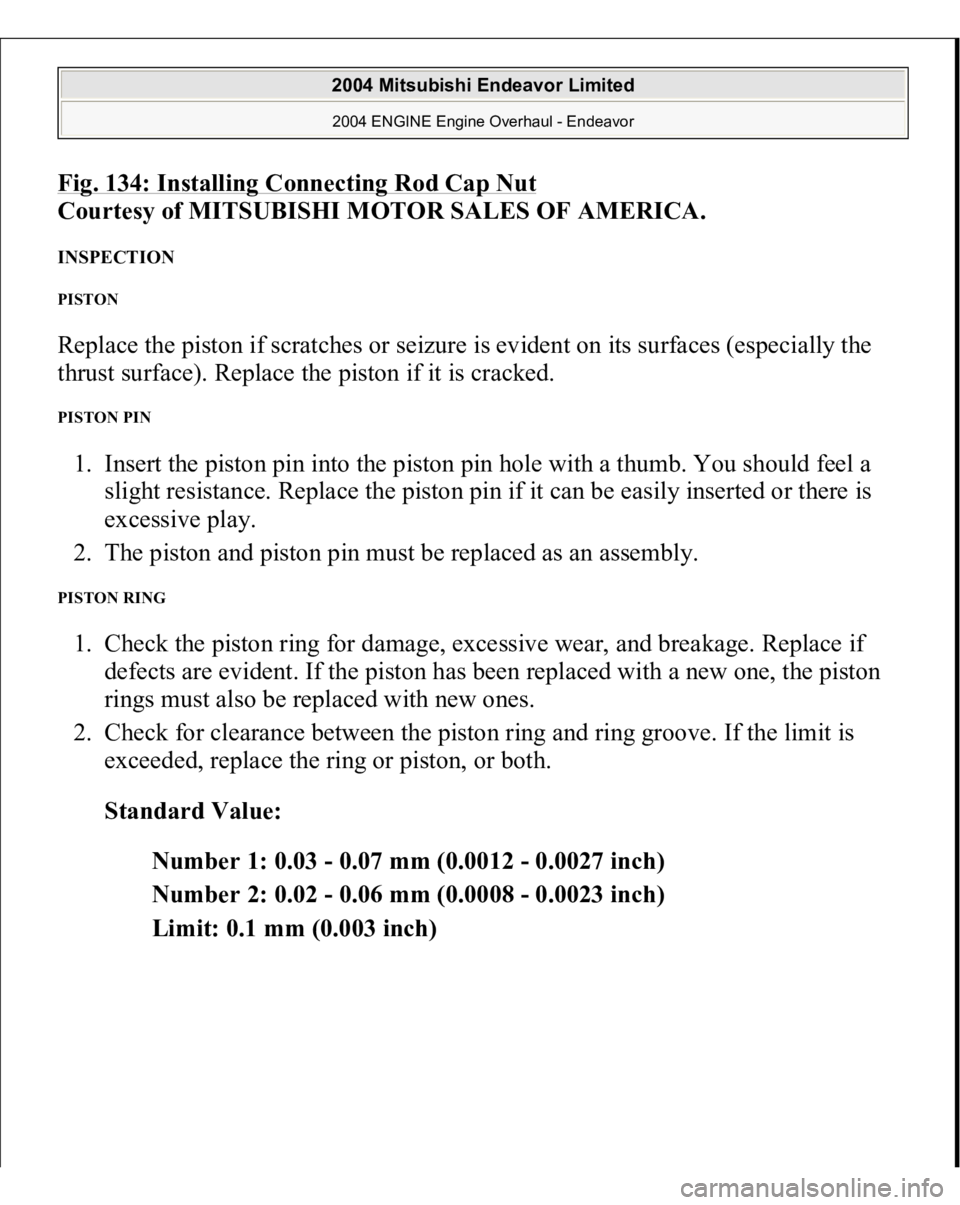
Fig. 134: Installing Connecting Rod Cap Nu
t
Courtesy of MITSUBISHI MOTOR SALES OF AMERICA.
INSPECTION PISTON Replace the piston if scratches or seizure is evident on its surfaces (especially the
thrust surface). Replace the piston if it is cracked. PISTON PIN 1. Insert the piston pin into the piston pin hole with a thumb. You should feel a
slight resistance. Replace the piston pin if it can be easily inserted or there is
excessive play.
2. The piston and piston pin must be replaced as an assembly. PISTON RING 1. Check the piston ring for damage, excessive wear, and breakage. Replace if
defects are evident. If the piston has been replaced with a new one, the piston
rings must also be replaced with new ones.
2. Check for clearance between the piston ring and ring groove. If the limit is
exceeded, replace the ring or piston, or both.
Standard Value:
Number 1: 0.03 - 0.07 mm (0.0012 - 0.0027 inch)
Number 2: 0.02 - 0.06 mm (0.0008 - 0.0023 inch)
Limit: 0.1 mm (0.003 inch)
2004 Mitsubishi Endeavor Limited 2004 ENGINE Engine Overhaul - Endeavor
Page 1501 of 3870
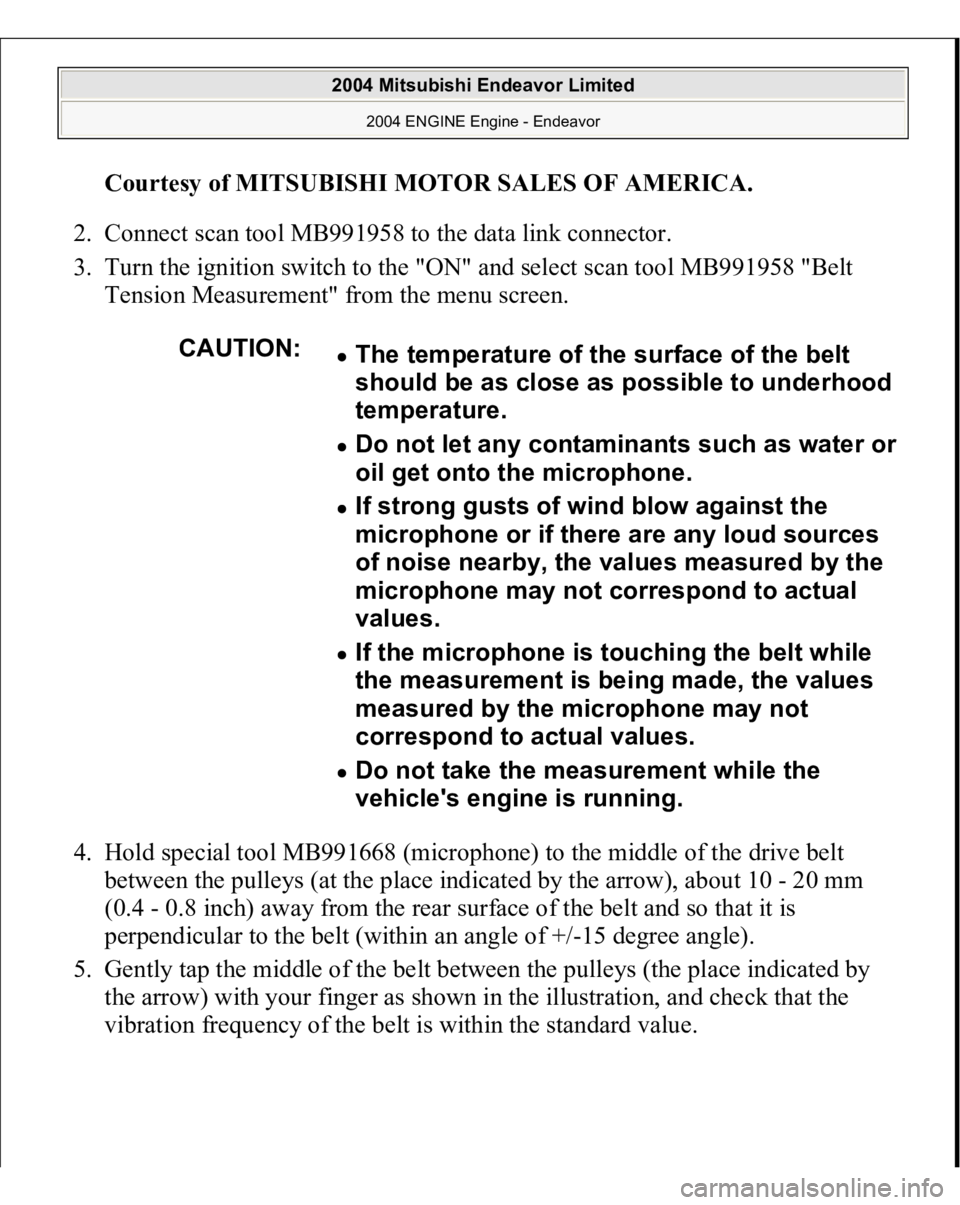
Courtesy of MITSUBISHI MOTOR SALES OF AMERICA
.
2. Connect scan tool MB991958 to the data link connector.
3. Turn the ignition switch to the "ON" and select scan tool MB991958 "Belt
Tension Measurement" from the menu screen.
4. Hold special tool MB991668 (microphone) to the middle of the drive belt
between the pulleys (at the place indicated by the arrow), about 10 - 20 mm
(0.4 - 0.8 inch) away from the rear surface of the belt and so that it is
perpendicular to the belt (within an angle of +/-15 degree angle).
5. Gently tap the middle of the belt between the pulleys (the place indicated by
the arrow) with your finger as shown in the illustration, and check that the
vibration fre
quenc
y of the belt is within the stan
dard value.
CAUTION:
The temperature of the surface of the belt
should be as close as possible to underhood
temperature. Do not let an
y contaminants such as water or
oil get onto the microphone.
If strong gusts of wind blow against the
microphone or if there are any loud sources
of noise nearby, the values measured by the
microphone may not correspond to actual
values. If the microphone is touching the belt while
the measurement is being made, the values
measured by the microphone may not
correspond to actual values. Do not take the measurement while the
vehicle's engine is running.
2004 Mitsubishi Endeavor Limited
2004 ENGINE Engine - Endeavor
Page 1511 of 3870
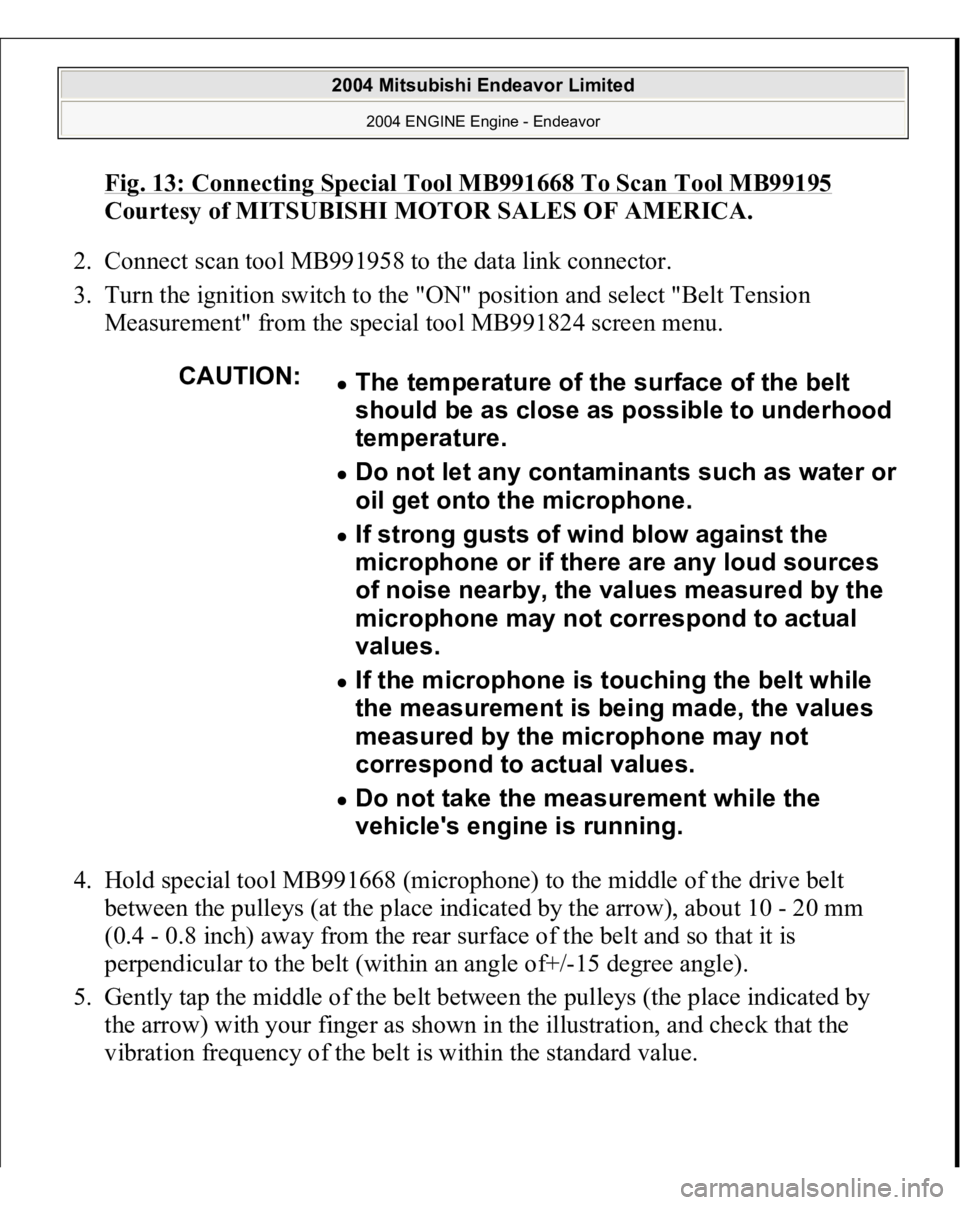
Fig. 13: Connecting Special Tool MB991668 To Scan Tool MB99195
Courtesy of MITSUBISHI MOTOR SALES OF AMERICA.
2. Connect scan tool MB991958 to the data link connector.
3. Turn the ignition switch to the "ON" position and select "Belt Tension
Measurement" from the special tool MB991824 screen menu.
4. Hold special tool MB991668 (microphone) to the middle of the drive belt
between the pulleys (at the place indicated by the arrow), about 10 - 20 mm
(0.4 - 0.8 inch) away from the rear surface of the belt and so that it is
perpendicular to the belt (within an angle of+/-15 degree angle).
5. Gently tap the middle of the belt between the pulleys (the place indicated by
the arrow) with your finger as shown in the illustration, and check that the
vibration frequency of the belt is within the stan
dard value.
CAUTION:
The temperature of the surface of the belt
should be as close as possible to underhood
temperature. Do not let any contaminants such as water or
oil get onto the microphone. If strong gusts of wind blow against the
microphone or if there are any loud sources
of noise nearby, the values measured by the
microphone may not correspond to actual
values. If the microphone is touching the belt while
the measurement is being made, the values
measured by the microphone may not
correspond to actual values. Do not take the measurement while the
vehicle's engine is running.
2004 Mitsubishi Endeavor Limited
2004 ENGINE Engine - Endeavor
Page 1531 of 3870
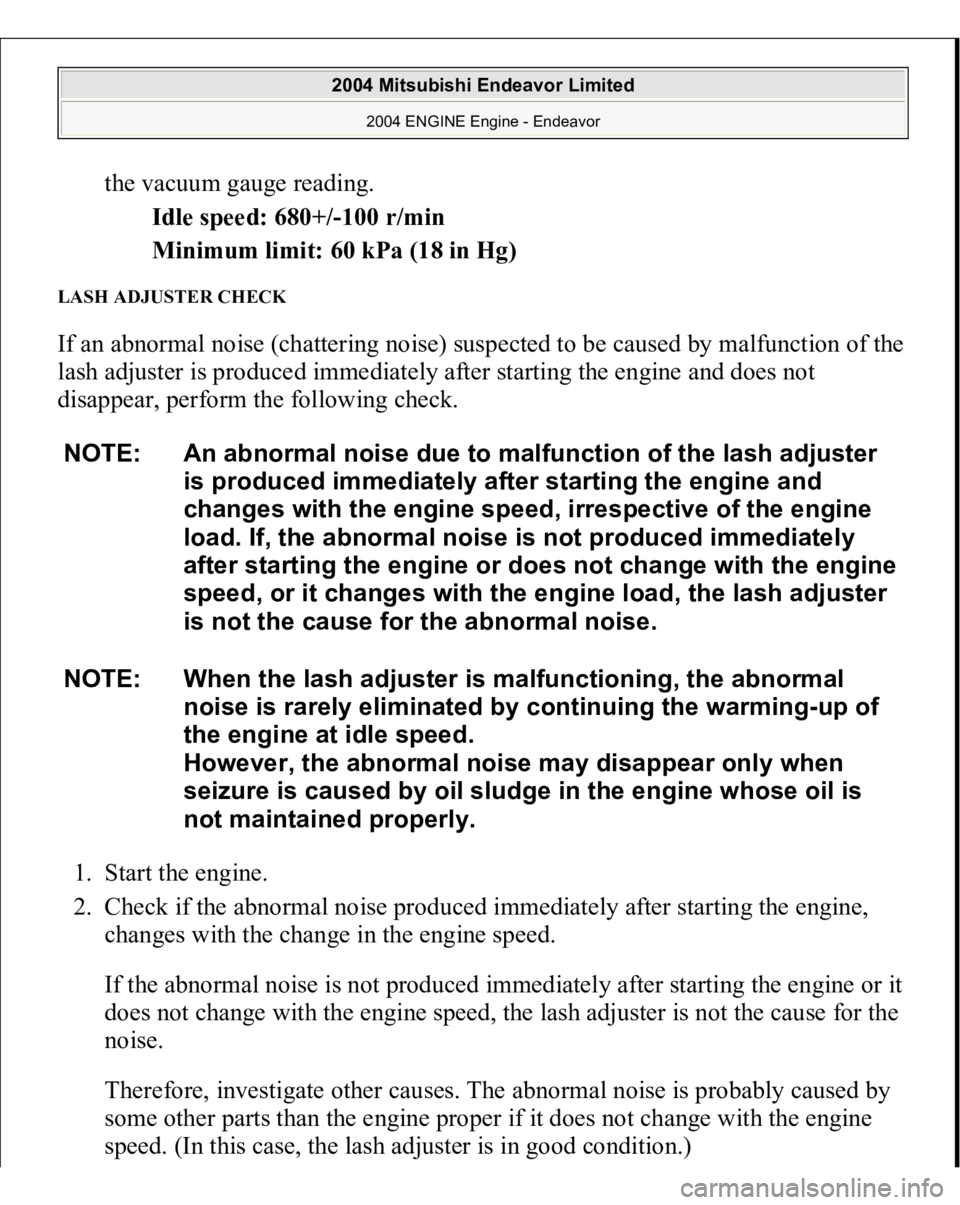
the vacuum gauge reading.
Idle speed: 680+/-100 r/min
Minimum limit: 60 kPa (18 in Hg)
LASH ADJUSTER CHECK If an abnormal noise (chattering noise) suspected to be caused by malfunction of the
lash adjuster is produced immediately after starting the engine and does not
disappear, perform the following check.
1. Start the engine.
2. Check if the abnormal noise produced immediately after starting the engine,
changes with the change in the engine speed.
If the abnormal noise is not produced immediately after starting the engine or it
does not change with the engine speed, the lash adjuster is not the cause for the
noise.
Therefore, investigate other causes. The abnormal noise is probably caused by
some other parts than the engine proper if it does not change with the engine
speed. (In this case, the lash adjuster is in good condition.)NOTE: An abnormal noise due to malfunction of the lash adjuster
is produced immediately after starting the engine and
changes with the engine speed, irrespective of the engine
load. If, the abnormal noise is not produced immediately
after starting the engine or does not change with the engine
speed, or it changes with the engine load, the lash adjuster
is not the cause for the abnormal noise.
NOTE: When the lash adjuster is malfunctioning, the abnormal
noise is rarely eliminated by continuing the warming-up of
the engine at idle speed.
However, the abnormal noise may disappear only when
seizure is caused by oil sludge in the engine whose oil is
not maintained properly.
2004 Mitsubishi Endeavor Limited
2004 ENGINE Engine - Endeavor
Page 1774 of 3870
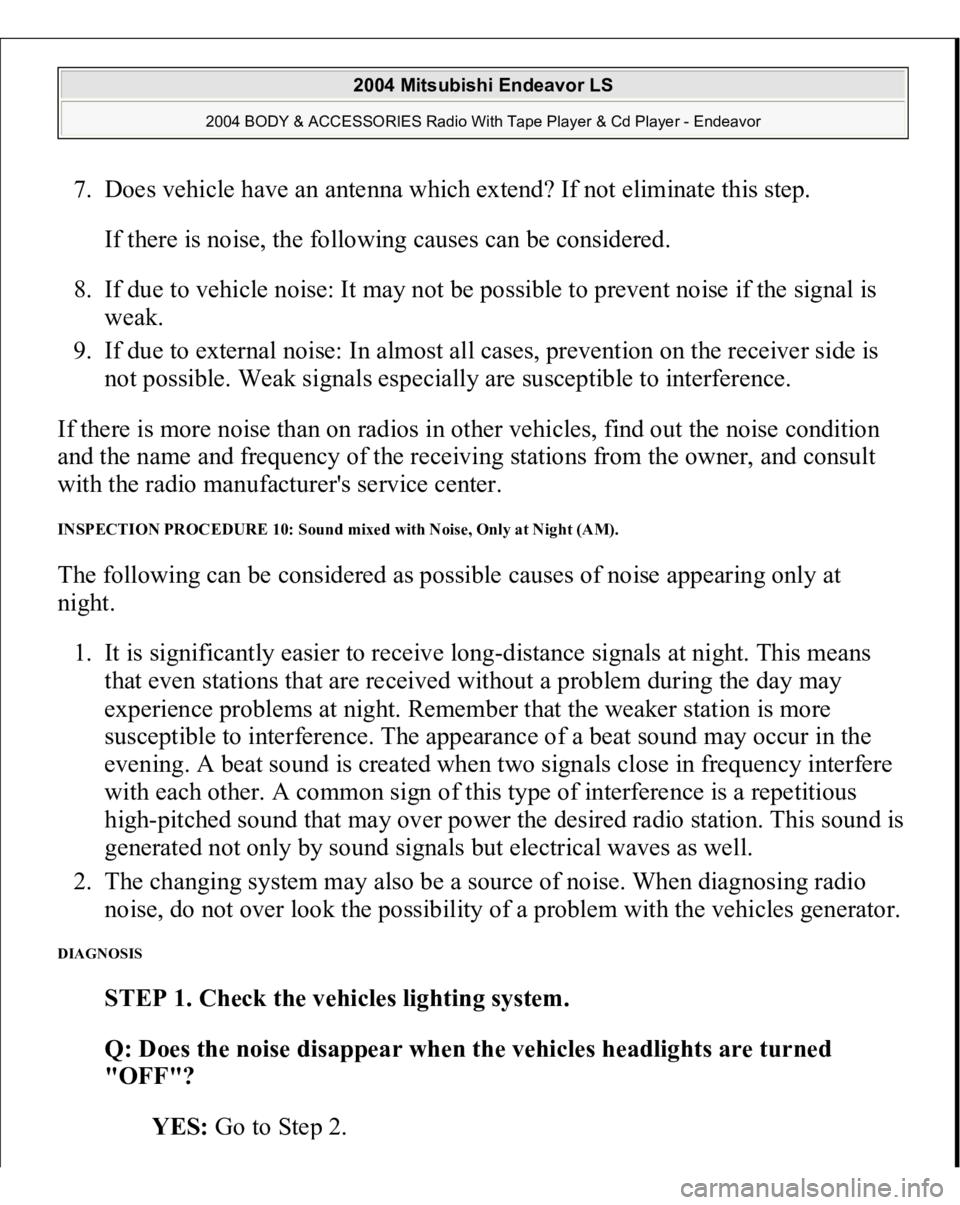
7. Does vehicle have an antenna which extend? If not eliminate this step.
If there is noise, the following causes can be considered.
8. If due to vehicle noise: It may not be possible to prevent noise if the signal is
weak.
9. If due to external noise: In almost all cases, prevention on the receiver side is
not possible. Weak signals especially are susceptible to interference.
If there is more noise than on radios in other vehicles, find out the noise condition
and the name and frequency of the receiving stations from the owner, and consult
with the radio manufacturer's service center. INSPECTION PROCEDURE 10: Sound mixed with Noise, Only at Night (AM). The following can be considered as possible causes of noise appearing only at
night.
1. It is significantly easier to receive long-distance signals at night. This means
that even stations that are received without a problem during the day may
experience problems at night. Remember that the weaker station is more
susceptible to interference. The appearance of a beat sound may occur in the
evening. A beat sound is created when two signals close in frequency interfere
with each other. A common sign of this type of interference is a repetitious
high-pitched sound that may over power the desired radio station. This sound is
generated not only by sound signals but electrical waves as well.
2. The changing system may also be a source of noise. When diagnosing radio
noise, do not over look the possibility of a problem with the vehicles generator. DIAGNOSIS
STEP 1. Check the vehicles lighting system.
Q: Does the noise disappear when the vehicles headlights are turned
"OFF"?
YES: Go to Ste
p 2.
2004 Mitsubishi Endeavor LS
2004 BODY & ACCESSORIES Radio With Tape Player & Cd Player - Endeavor
Page 1888 of 3870
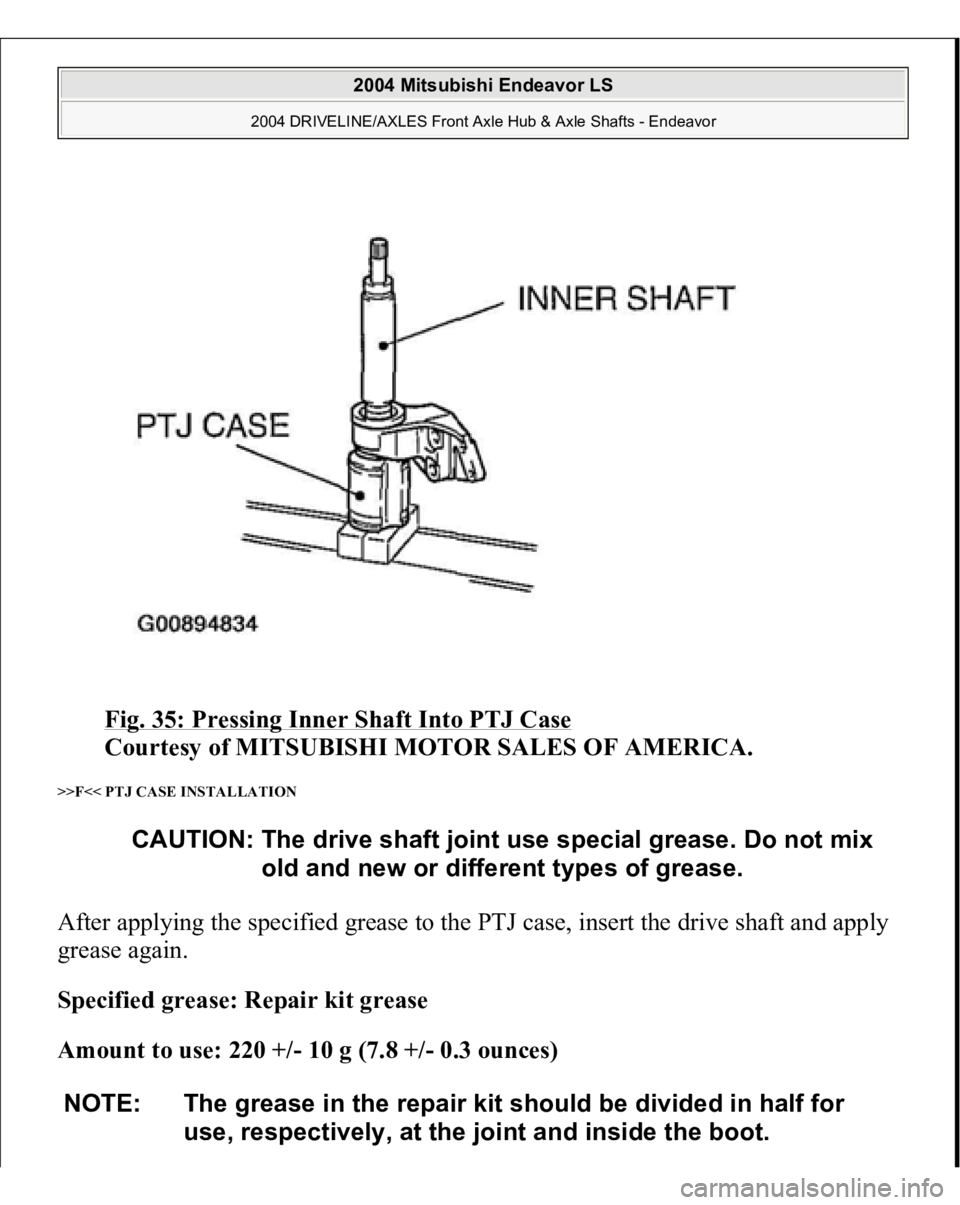
Fig. 35: Pressing Inner Shaft Into PTJ Case
Courtesy of MITSUBISHI MOTOR SALES OF AMERICA.
>>F<< PTJ CASE INSTALLATION After applying the specified grease to the PTJ case, insert the drive shaft and apply
grease again.
Specified grease: Repair kit grease
Amount to use: 220 +/- 10 g (7.8 +/- 0.3 ounces)
CAUTION: The drive shaft joint use special grease. Do not mix
old and new or different types of grease.
NOTE: The grease in the repair kit should be divided in half for
use, respectively, at the joint and inside the boot.
2004 Mitsubishi Endeavor LS
2004 DRIVELINE/AXLES Front Axle Hub & Axle Shafts - Endeavor
Page 1897 of 3870
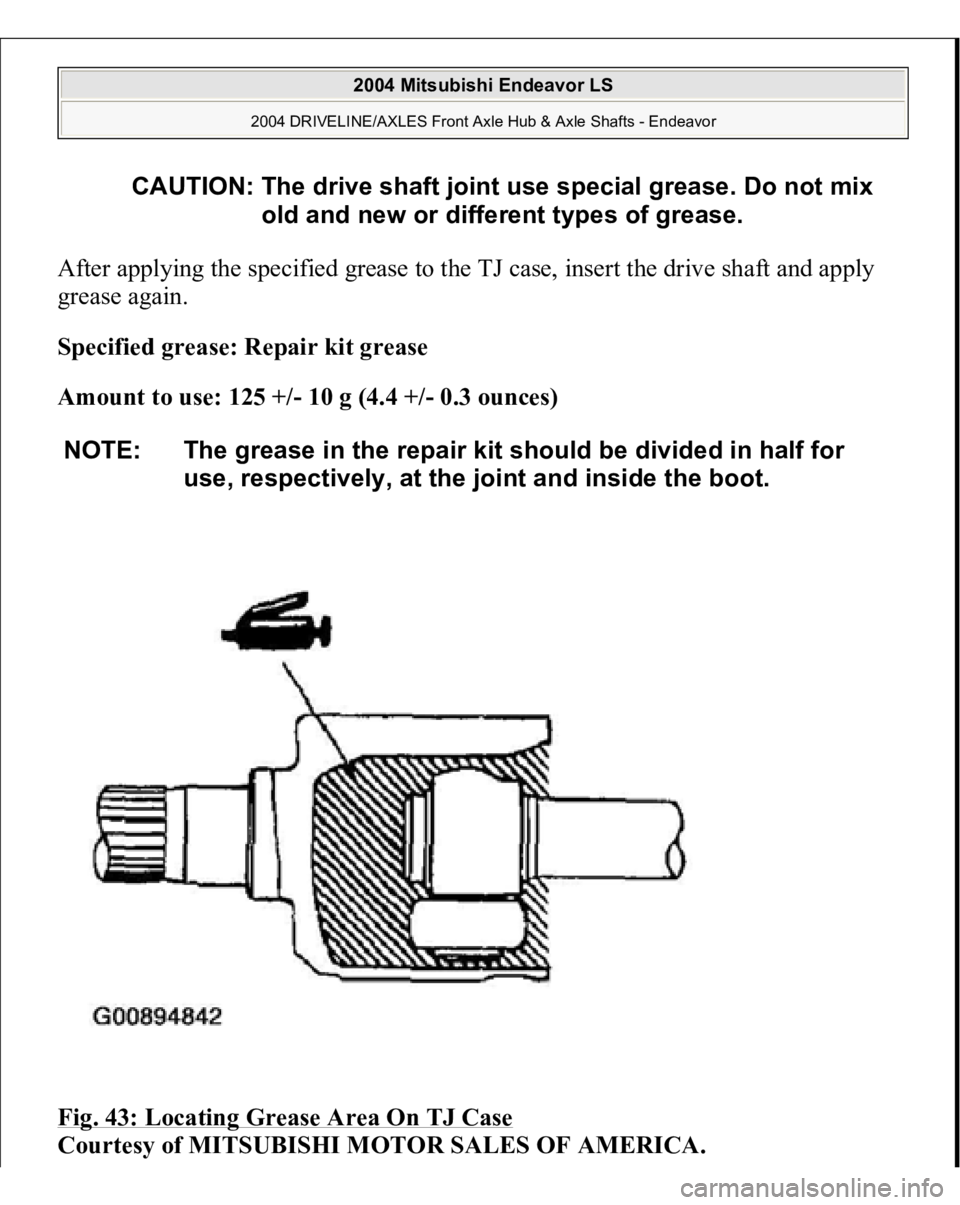
After applying the specified grease to the TJ case, insert the drive shaft and apply
grease again.
Specified grease: Repair kit grease
Amount to use: 125 +/- 10 g (4.4 +/- 0.3 ounces)
Fig. 43: Locating Grease Area On TJ Case
Courtesy of MITSUBISHI MOTOR SALES OF AMERICA.
CAUTION: The drive shaft joint use special grease. Do not mix
old and new or different types of grease.
NOTE: The grease in the repair kit should be divided in half for
use, respectively, at the joint and inside the boot.
2004 Mitsubishi Endeavor LS
2004 DRIVELINE/AXLES Front Axle Hub & Axle Shafts - Endeavor
Page 1926 of 3870
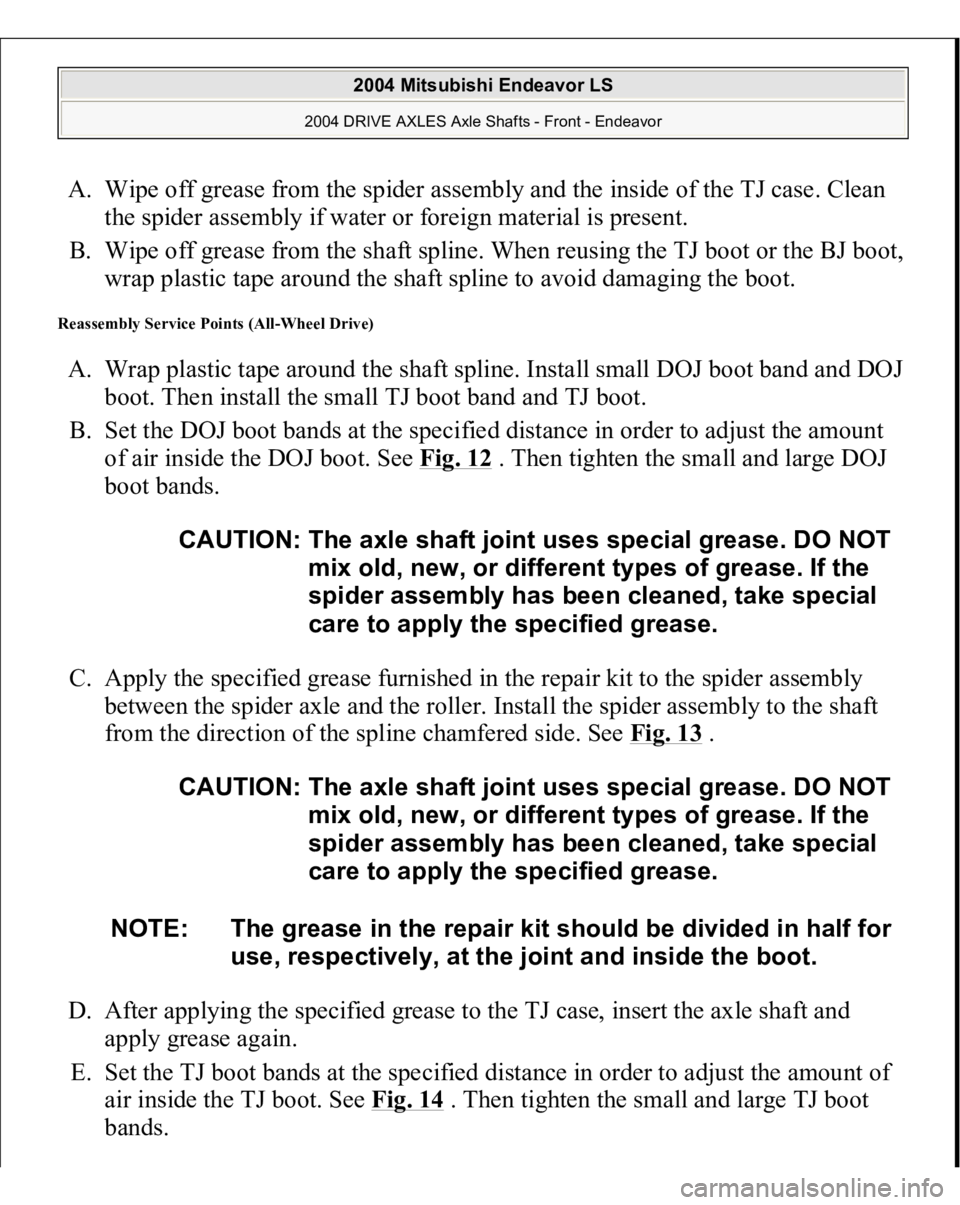
A. Wipe off grease from the spider assembly and the inside of the TJ case. Clean
the spider assembly if water or foreign material is present.
B. Wipe off grease from the shaft spline. When reusing the TJ boot or the BJ boot,
wrap plastic tape around the shaft spline to avoid damaging the boot. Reassembly Service Points (All-Wheel Drive) A. Wrap plastic tape around the shaft spline. Install small DOJ boot band and DOJ
boot. Then install the small TJ boot band and TJ boot.
B. Set the DOJ boot bands at the specified distance in order to adjust the amount
of air inside the DOJ boot. See Fig. 12
. Then tighten the small and large DOJ
boot bands.
C. Apply the specified grease furnished in the repair kit to the spider assembly
between the spider axle and the roller. Install the spider assembly to the shaft
from the direction of the spline chamfered side. See Fig. 13
.
D. After applying the specified grease to the TJ case, insert the axle shaft and
apply grease again.
E. Set the TJ boot bands at the specified distance in order to adjust the amount of
air inside the TJ boot. See Fig. 14
. Then tighten the small and large TJ boot
bands.
CAUTION: The axle shaft joint uses special grease. DO NOT
mix old, new, or different types of grease. If the
spider assembly has been cleaned, take special
care to apply the specified grease.
CAUTION: The axle shaft joint uses special grease. DO NOT
mix old, new, or different types of grease. If the
spider assembly has been cleaned, take special
care to apply the specified grease.
NOTE: The grease in the repair kit should be divided in half for
use, respectively, at the joint and inside the boot.
2004 Mitsubishi Endeavor LS
2004 DRIVE AXLES Axle Shafts - Front - Endeavor